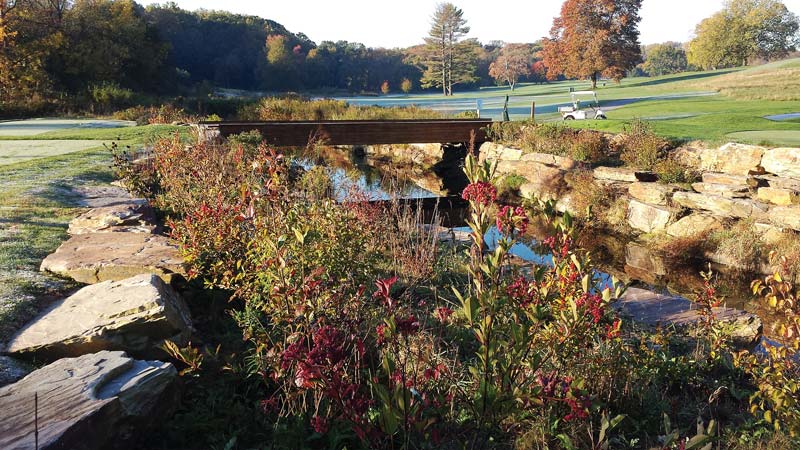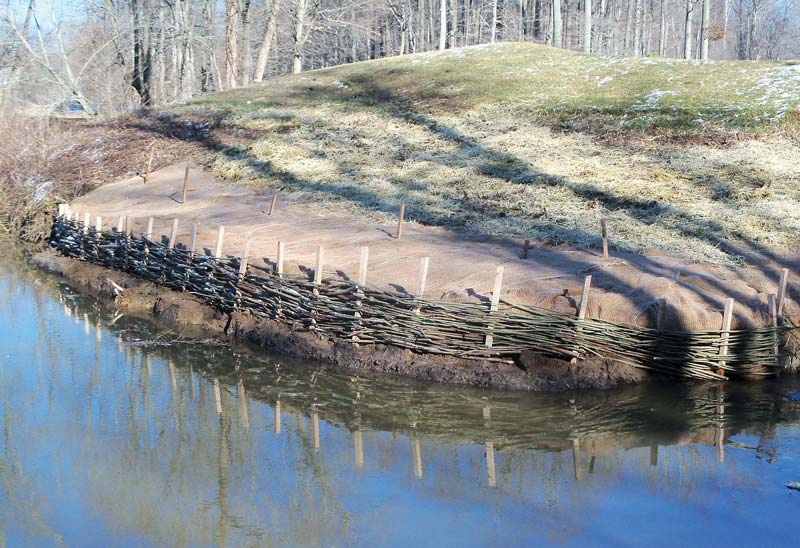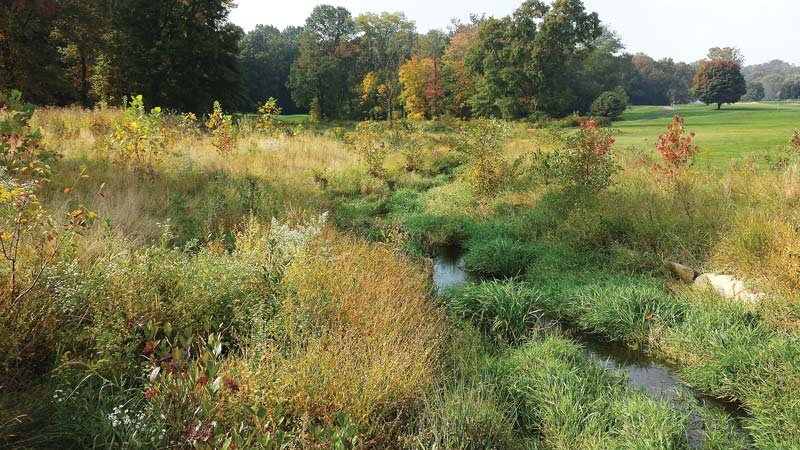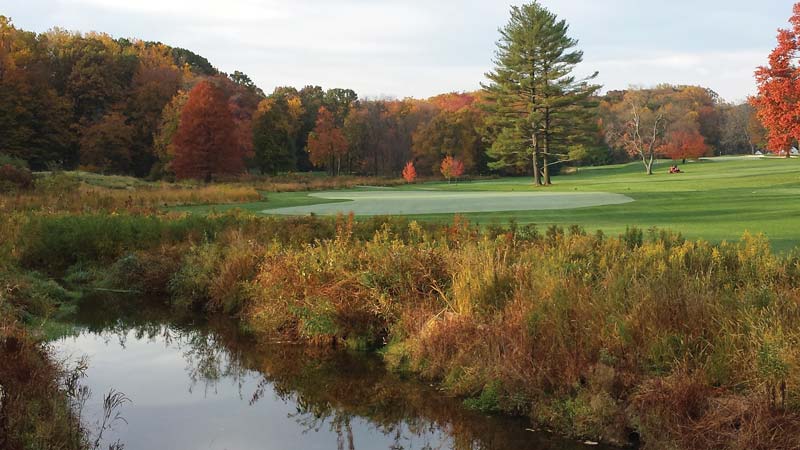
Paul Stead, CGCS, faced an intruding stream that hindered play and threatened course infrastructure when he began overseeing Kennett Square (Pa.) Golf and Country Club in 2005. Twelve years later, the transformed stream is not only no longer a risk, but is an asset within the Red Clay Creek watershed. Photos courtesy of Paul Stead
Many golf courses incorporate streams, and unlike those in most parts of the humanized landscape, streams that traverse golf courses tend to be long and generally aren’t confined by immovable infrastructure, such as buildings and sewer lines. These factors make golf courses ideal locations for restoration of stream corridors — the valuable, dynamic ecosystems consisting of the stream, its surrounding land and plants, and the area’s animal inhabitants.
Through stream corridor restoration, golf courses are in a unique position to make meaningful environmental enhancements, such as improvements to stream channel stability, safeguarding of water quality, decreased downstream impacts from flood flows, and the establishment of habitat conditions welcoming to wildlife, from small mammals to birds to native butterflies and bees. Stewardship over such a large span of stream can have considerable positive effects within the watershed and beyond.
All of those environmental benefits — erosion control, water quality protection, flood reduction and habitat creation — figured into the restoration of the nearly half-mile section of the east branch of Red Clay Creek that passes through Kennett Square (Pa.) Golf and Country Club. While the project was driven primarily by the need to make crucial adjustments to the golf course, the club seized the opportunity to, at the same time, become a responsible partner within the 54-square-mile Red Clay Creek watershed in southern Chester County, Pa., and northern New Castle County, Del. The watershed contains sources of drinking water, and the Red Clay Creek empties into the Delaware River and ultimately the Atlantic Ocean.
A stream runneth over
Kennett Square Golf and Country Club (KSGCC) sits on 135 acres of former farmland in southeast Pennsylvania. It’s near the top of the Red Clay Creek watershed and about 2 miles south of Red Clay Creek’s headwaters. The stream runs through the east end of the 18-hole private course, beginning between the 13th green and 14th tee. It flows south across the 14th fairway and continues in front of the 16th tee before exiting the course behind the 15th green. Most of Red Clay Creek’s east branch was channelized when the golf course was constructed about 80 years ago. This modification of water flow along with gradual urbanization and increased runoff upstream of KSGCC had transformed the creek into an ugly, incised and eroding watercourse that not only affected the beauty of the property, but was chewing away at neighboring fairways, greens and tees.
Deteriorating banks were bringing the stream extremely close to the 13th green and 14th tee. Flooding could cause 3 to 4 feet of bank to disappear overnight. After flooding, which would occur several times in summer, water would be impounded on the 14th fairway by a berm that had built up over time from sediment deposited during previous flooding. Up to two days could be required for the water to recede and the fairway to dry out enough to accommodate carts. If the stream flooded during an event, such as the member-guest tournament, the entire fairway may not have been playable for the remainder of the tournament.
While the stream bank erosion had started as just a little here and there, it had picked up momentum as the years passed. If no action were taken, the 14th tee would have eroded within two years, and three bridges over the stream were in danger of being washed out during storms. As the stream infringed upon the 14th fairway, irrigation pipes were becoming exposed, and if left unchecked, the pipes would have eventually blown out.
These local imbalances were also having serious repercussions downstream. Because of the accelerated bank erosion, the stream reach through KSGCC was a significant contributor to excess sediment downstream and, ultimately, to the Delaware River Estuary, which has been severely impacted by high sediment loads from the Red Clay Creek watershed. Incision (deepening of the stream bed) and simplification of the creek were also causing it to act more like a pipe (albeit a crooked one) than a stream, speeding floodwaters downstream instead of helping retain the current during major storms, as a more natural, stable stream would do. Such healthier streams possess a floodplain — a section of adjacent low ground that helps delay the progress of flowing water and thus mitigates bank erosion. As water spills out onto the flood-prone surface, it’s absorbed or is slowed down by friction with the ground and vegetation. Re-creation of such an area anywhere space would allow would be a cornerstone of the Red Clay Creek corridor restoration.
Navigating the restoration waters
The idea to take on stream corridor restoration at KSGCC was hatched shortly after superintendent Paul Stead, CGCS, joined the staff in 2005. Stream bank erosion had already begun, and the club was considering a short-term solution that wouldn’t have been sufficient to prevent further damage. With help from the Chester County Conservation District and the Red Clay Valley Watershed Association (now the Brandywine Red Clay Alliance), Stead was able to convince the membership that an isolated repair would not hold up long. Without something more holistic, the infrastructure of the course would remain in jeopardy.
The cost to the club was nearly $600,000, of which $225,000 went toward upgrades to playable parts of the course adjacent to the restoration, including reconstruction of the 14th fairway. The total cost was approximately $800,000, with the additional balance covered by grants from the Pennsylvania Department of Environmental Protection. In searching for grants, the restoration team found that the likelihood of securing funding would increase if KSGCC could help decelerate flood waters, reduce sediment downstream and cultivate habitat, which helped shape the project’s objectives.
The revamped corridor was designed by the engineering and environmental services firm Skelly and Loy Inc. of Harrisburg, Pa., whose proposal involved the least amount of disturbance to both course and stream. Stead worked with Skelly and Loy restoration specialist Todd Moses on the design concept. The process of obtaining the joint permit between the Army Corps of Engineers and the Pennsylvania Department of Environmental Protection took just over a year. The company Flyway Excavating, also of Pennsylvania, had experience tackling similar projects for the Red Clay Valley Watershed Association and was chosen to do the construction.
After years of planning and garnering support, renovation of the stream corridor got underway in November 2011. The main element of the project was “re-coupling” a quarter-mile of stream to reinstate a floodplain. The pre-restoration stream was about 3 feet deep, with sharp vertical banks, meaning water had a substantial distance to rise before it could spill out over the floodplain. Pulling soil back from the stream to form a gradually lower, flatter bank along one or both sides of the channel produced a variable-width (10- to 20-foot) floodplain, which reduced the speed of the stream’s water and the resulting bank erosion.
In map view, the pre-restoration stream was a straightened channel made mildly sinuous by roughly 80 years of erosion. This geometry was only slightly altered in the restoration, as the focus was more on the stream’s banks than its path. Boulder banks were constructed along concave (erosion-prone) channel bends, and large woody debris was integrated for in-stream habitat enhancement where feasible. Woven willow branches were used to stabilize a smaller section of stream bank where proximity to the green prohibited lowering the bank’s angle. A piped section of a tributary that originates on a neighboring property was “daylighted” and revived as an aboveground stream.

Woven willow forms a natural barrier that withstands and deflects stream water flow behind the 15th green. This bank stabilization technique is known as “spiling.”
Establishing a riparian buffer along Red Clay Creek using indigenous tree, shrub and plant species was central to this project. Only herbaceous vegetation was planted in areas where visibility down the fairway was necessary. The remaining floodplain was planted to tree and shrub species to provide habitat as well as shade the stream (lowering the water’s temperature allows it to better support aquatic wildlife). An exceptionally diverse palette of native plants was installed to maximize biodiversity and supply a food source for native songbirds along with wild bees and butterflies. Construction of the renovated stream corridor wrapped up in May 2012.
Corridor care
The first year of maintenance is critical in any stream corridor restoration. At KSGCC, live cover needed to be established quickly to furnish erosion control (the stream flows high and fast during rainstorms), and the plants also needed to be able to compete with the aggressive weeds that abound in southeast Pennsylvania. KSGCC coordinated with nurseries and greenhouses ahead of time to obtain the desired seed, live stakes and container-started plants. The planted corridor was watered two to three times per week throughout the summer, with the frequency tapering off in the fall. (Adequate watering is sometimes neglected during a stream corridor’s first growing season, but it’s essential to long-term viability.)
In the first year following many stream corridor restorations, about 50 percent of plant material is lost because of a lack of care. KSGCC’s restoration — the largest to date within the Red Clay Creek watershed — had more than 90 percent survival, and the banks were stabilized quickly. Wildlife returned, with young animals and fish appearing where only adults had been observed previously.
The first year’s growth consisted mostly of grasses, which needed to be cut back using a string trimmer every four to six weeks, with care taken not to damage new woody plantings. Regular trimming also helped keep invasive weeds — which quickly colonize disturbed, sunny sites — to a minimum, and this tactic was supplemented with occasional hand pulling.
Native perennial wildflowers started to emerge during the second full growing season after construction. While a wide assortment of these plants was the goal, it also made maintenance a bit more difficult, as Stead and his crew had to learn how to distinguish many of the weeds from the pre-flowering natives. Dominant weed plants were kept from going to seed via hand clipping, which took one person a few hours each month.

Completed restoration work on the tract of Red Clay Creek that travels the 14th fairway. To the right of the stream is a reforested section of land, connecting the stream corridor to existing woods. Shrubs lining the stream include serviceberry, winterberry and several Viburnum species.

In recognition of KSGCC’s stream restoration initiative, the Red Clay Valley Watershed Association honored the club with its 2014 Outstanding Conservationist award.
A more methodical approach was possible by the third growing season, with the realization that most of the native perennials wouldn’t emerge until late spring, while most of the weeds and problem grasses arrived early in spring. Selective mowing in May would set these grasses back and let the native wildflowers catch up, giving them a chance to compete. Among the problematic weeds in KSGCC’s restoration was reed canary grass (Phalaris arundinacea), a common invader in disturbed wet sites in the Northeast. Stead’s team employed targeted applications of sethoxydim to control the grass without harming broadleaf plant material. Other dominant weeds included Japanese hops (Humulus japonicus), which took one person about two hours a week to pull for three to four weeks in early summer, and Canada goldenrod (Solidago canadensis), which, while native to the area, is a rapid spreader that can crowd out more desirable perennials on drier microsites. The crew hand-clipped this plant to keep it beneath the top growth of the preferred species and prevent it from going to seed.
As the five years since the corridor construction have demonstrated, diligent aftercare has been a major component of its success. Weed control is vital with such a large-scale installation of native plants, and the time for it must be budgeted beforehand. Stead and his crew continue to work to identify the most efficient way to manage invasive weeds along the stream. The task currently requires eight to 10 hours a month throughout the first half of the growing season. Environmental landscaping classes and assistance from local experts have helped the agronomy team keep the corridor’s corresponding in-play areas aesthetically pleasing, which can be a struggle at times, particularly in spring. Heavy rain still causes flooding on the 14th fairway, as was expected, but the water recedes (and play can resume) within an hour — rather than days — after the rain has stopped.
A ripple effect
As the completed stream corridor restoration has matured, KSGCC has pursued other environmentally minded projects, aiming mainly to minimize course maintenance (especially mowing) and create more habitat on the property. A number of formerly mowed parts of the course have been re-naturalized to forest or meadow. As these areas become established, they will link the stream corridor to formerly isolated forest fragments and add usable habitat. Restoring native vegetation to these spaces has likewise reduced the amount of land that needs fertilizer and herbicides. Numerous out-of-play areas are also being converted to hard fescue, a drought-tolerant grass that doesn’t require regular mowing or fertilizer. The maintenance team is less diligent about string-trimming everywhere along the wood line, which has allowed native milkweed (Asclepias) — a critical food source for the iconic but imperiled monarch butterfly — to recolonize the areas. Inspired by the pollinator activity brought about by the wildflowers along the stream, Stead took up keeping honey bees on the course, an initiative that’s now in its third season.
The club has installed rain gardens to intercept runoff from the maintenance facility’s vehicle washing and servicing areas as well as the KSGCC clubhouse parking lot. In addition, several small ponds that tend to develop algae cover during the heat of summer will be converted to runoff-treatment wetlands. The club performs regular water-quality sampling where the Red Clay Creek enters and leaves the property, and hosts conservation-focused tours of the stream and its surroundings. Representatives from a local bird club visit once a month to do a bird count, and the club is planning to conduct surveys of native pollinators and provide the findings to the Pennsylvania Department of Agriculture.
Efforts like the stream corridor restoration at KSGCC allow golf courses to have a softer environmental footprint while also taking on a lead role in their communities, and they are an important part of a larger effort to reshape the way we think about our inhabited landscapes. Attractive, exciting golf courses don’t need to have the highly manicured — and biologically sterile and energy-intensive — features common to so many “traditional” courses.
Partnering with your local conservation district and watershed association is imperative to a project like this. The people in these groups are experts in improving water quality, are well connected with the best firms and contractors, and are willing to help guide you through the process. Taking on such a sizable project without their assistance would be difficult. Another key element is patience, as stream corridor restorations and similar ventures take years to see through from initial conception to completion. Even after construction is done, the work isn’t finished — these investments require continual care, but they are investments that are enormously worthwhile, and that exemplify how golf courses can be more than just recreational spaces whose environmental stewardship ceases at their property lines.
Paul Stead, CGCS, is the golf course superintendent at Kennett Square (Pa.) Golf and Country Club, where he has worked for 12 years. A 32-year GCSAA member, Paul earned a two-year turf management certificate from Penn State University and has been a certified superintendent since 1993. He is a member of the Philadelphia Association of Golf Course Superintendents. Todd Moses is a restoration designer with Skelly and Loy Inc. in Harrisburg, Pa.